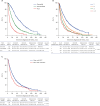Sites of Metastasis and Survival in Metastatic Renal Cell Carcinoma: Results From the Korean Renal Cancer Study Group Database
- PMID: 39592128
- PMCID: PMC11596476
- DOI: 10.3346/jkms.2024.39.e293
Sites of Metastasis and Survival in Metastatic Renal Cell Carcinoma: Results From the Korean Renal Cancer Study Group Database
Abstract
Background: In patients with metastatic renal cell carcinoma (mRCC), sites of metastatic involvement have been reported to be associated with a difference in survival. However, the frequency and survival according to different sites of metastases in Korean patients with mRCC remain unclear. Therefore, this study aimed to assess the frequency of metastatic site involvement and the association between sites of metastatic involvement and survival in Korean patients with mRCC.
Methods: This retrospective study used the multicenter cohort of the Korean Renal Cancer Study Group mRCC database to identify patients who started targeted therapy between December 2005 and March 2018. Data on the frequency of metastatic organ involvement at the time of mRCC diagnosis and oncologic outcomes according to different sites of metastasis were analyzed.
Results: A total of 1,761 patients were eligible for analysis. Of the 1,761 patients, 1,564 (88.8%) had clear cell RCC, and 1,040 (59.1%) had synchronous metastasis. The median number of metastasis sites was 2 (interquartile range [IQR], 1-6). The median age at the initiation of systemic therapy was 60 years (IQR, 29-88), 1,380 (78.4%) were men, and 1,341 (76.1%) underwent nephrectomy. Based on the International Metastatic Renal Cell Carcinoma Database Consortium model, patients were stratified into favorable-, intermediate-, and poor-risk groups with 359 (20.4%), 1,092 (62.0%), and 310 (17.6%) patients, respectively. The lung (70.9%), lymph nodes (37.9%), bone (30.7%), liver (12.7%), adrenal gland (9.8%), and brain (8.2%) were the most common sites of metastasis, followed by the pancreas, pleura, peritoneum, spleen, thyroid, and bowel. Among the most common sites of metastasis (> 5%), the median cancer-specific survival (CSS) ranged from 13.9 (liver) to 29.1 months (lung). An association was observed between liver, bone, and pleural metastases and the shortest median CSS (< 19 months).
Conclusion: In Korean patients with mRCC, metastases to the lung, lymph nodes, bone, liver, adrenal gland, and brain were more frequent than those to other organs. Metastases to the liver, bone, and pleura were associated with poor CSS. The findings of this study may be valuable for patient counseling and guiding future study designs.
Keywords: Carcinoma, Renal Cell; Molecular Targeted Therapy; Neoplasm Metastasis; Prognosis; Survival.
© 2024 The Korean Academy of Medical Sciences.
Conflict of interest statement
The authors have no potential conflicts of interest to disclose.
Figures




References
MeSH terms
LinkOut - more resources
Full Text Sources
Medical

